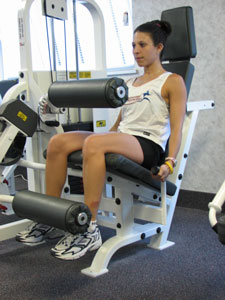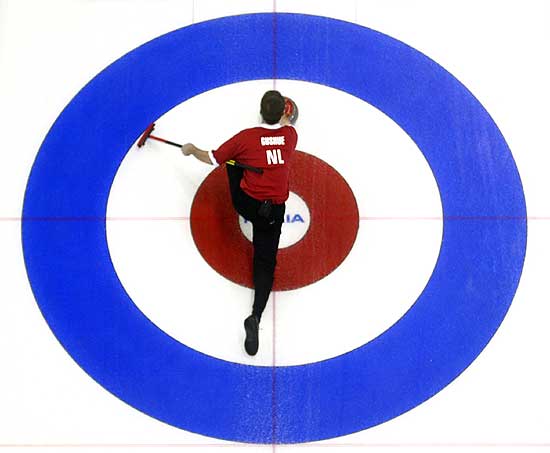How Functional is Functional??
Trainers love to throw around the term “functional training” like it’s their grandma’s prized china fresh out of the dish washer. They use claims like “functional training utilizes exercises that emulate the movements of life,” or my personal favorite “Squats are tha awesome!!! They make you wicked strong and are better than anything ever always!!” Word.
 So here’s the thing. Ask 50 trainers what functional training means and you’re going to get 50 different answers. Ask 50 non-trainers what functional training is and you’ll get that ever-so-fantastic deer in the headlights look. Face it, it’s the buzz word of the industry. It seems to have become so diluted that it has lost all meaning.
So here’s the thing. Ask 50 trainers what functional training means and you’re going to get 50 different answers. Ask 50 non-trainers what functional training is and you’ll get that ever-so-fantastic deer in the headlights look. Face it, it’s the buzz word of the industry. It seems to have become so diluted that it has lost all meaning.
Now, most of the well-read trainers out there, who walk their talk and like to think they have their callused fingers on the pulse of the industry will get all sweaty in their Vibrams and twitchy while holding a protein shaker and exclaim for all to hear “Functional training is when you perform activities that replicate activities you do in real life!!” Sure, I’ll buy that. But if that was the case, people wouldn’t use barbells, dumbells, TRX, bosu balls, elastics, cables, rowing machines, or any other weight-loaded machine out there, because life rarely has handles, pre-set weights, ergonomic alignment, or inflated surfaces. A growing thought process about functional training is beginning to get refined, and a rough outline of it would be:
Any training that results in the desired improvements in physical capability, by using the most optimal and safest methods possible.
Sounds pretty fair and complete, doesn’t it? Because after all, we all work out to see some sort of results, whether that be fat loss, muscle gain, strength improvements, or what have you. But let’s look deeper at some of these functional training fallacies.
If I asked you what would be more functional for improving performance in the squat, a body weight squat standing on the bosu ball or an isometric hold on the leg extension machine with the knee flexed to 70 degrees, which would produce the biggest results? Pretty much everyone out there would say without hesitation that squatting would produce the biggest bang for your buck, and that a leg extension machine is the biggest scam in the history of Charlie Sheen’s rehab.
Well, I would venture to say that everyone out there would be completely wrong on this one. Sure, it makes some sense that training a squat would make the squat better, but we forget about the principle of overload by placing the individual on a labile (unstable) surface. By doing this, Kohler et al (2010) showed that as the stability of the surface decreased, the total amount of resistance that could be used was reduced as well. What this means is that by standing on anything other than solid ground, we reduce the amount of load we can place on the body, and therefore reduce the amount of physical benefit we can derive from the exercise. Crazy, ain’t it? What’s even more crazy is that Zatsiorsky and Raitsin (1974) found that training the leg extension mechanism in an isometric manner at 70 degrees of knee extension (so almost at a full knee bend) resulted in an 11.5 kg increase in maximal squat performance, and a second group in the same study trained at 130 degrees of extension (almost fully extended) and only improved squat performance by 7.5 kg. Drinkwater et al (2007) showed that squatting on a bosu with any type of load would result in piss-poor mechanics (my term, not his) and probably wind up creating a new client for me to fix after they go and hurt themselves. That, and the fact that they can’t lift as much on the bosu, and the muscles don’t get the adequate stimulation to see gains (his words, not mine).
End results: You’re less functional on a BOSU, and way less diesel by using a BOSU to get your crush on in the gym. Women will laugh at you, and little kids will beat you up and steal your lunch money. Again.
In these examples, if you wanted to get stronger you would use the leg extension, but not the entire range of motion, just the bottom part.
Another major allure of functional training is that it activates more muscles. Well, sure. But how hard are they working? I can guarantee they will work a lot harder by lifting some heavy shit off the floor, or walking across the gym while holding it than by standing on one floor on an unstable surface while flipping a kettlebell around like a complete tool.
 If you’re looking to functional training as a form of weight loss, you’re sadly mistaken. Hansen et al (2009) showed that a 12 week program of strength and cardio training resulted in an average decrease in body fat of 0.4%, and actually showed a decrease in their functional fitness tasks, where the control group actually improved their ability!! Essentially, they de-trained the strength group and make them worse than the un-trained group!! Fail.
If you’re looking to functional training as a form of weight loss, you’re sadly mistaken. Hansen et al (2009) showed that a 12 week program of strength and cardio training resulted in an average decrease in body fat of 0.4%, and actually showed a decrease in their functional fitness tasks, where the control group actually improved their ability!! Essentially, they de-trained the strength group and make them worse than the un-trained group!! Fail.
Compare that with my interval experiment, where over 6 hours of total work in 6 weeks, my body fat went down 2.01%, and my VO2 max increased 8.3%, and all I did was run my ass off on a treadmill at a stupid-high intensity for a very short period of time. That’s right, my method was hella better.
So in conclusion, Functional Training needs to back the truck up and think about why it’s doing what it’s doing. If there’s a warm body in front of you paying to get results, then do your research to figure out how to get that client their results in the best way possible, without killing them. Sure, Granny may want to tighten her bat wings on her triceps, but that doesn’t mean she will succeed at all-out sprints right out the gate, so she may need to be eased into it. Also, Granny would probably benefit from some balance training to make sure she doesn’t fall on the ice and break a hip, so get her on the BOSU once in a while to get her balance up, but then put her on the ground and load some weights on her back to make her wicked strong. She’ll be curling with the other gals in the blue-hair group in no time, and rippin that rock down the ice like no one’s business.
Note: That’s right, I just made a curling reference. American readers, look that shit up. It will blow your mind. We Canadians get into a lather about this sport.



7 Responses to How Functional is Functional??